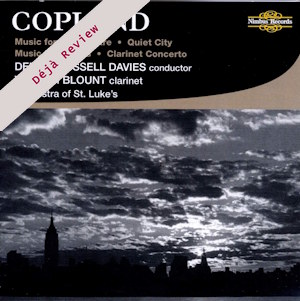
Déjà Review: this review was first published in February 2009 and the recording is still available.
Aaron Copland (1900-1990)
Music for the Theater (1925)
Quiet City (1940)
Music for Movies (1942)
Clarinet Concerto (1947/48)
William Blount (clarinet)
Orchestra of St Luke’s/Dennis Russell Davies
rec. c. 1988
Nimbus NI2522 [67]
This is a lovely collection of music from Copland’s first 25 years as a professional composer and the style varies from the naughty boy jazz–inflected Music for the Theater, through the urban blues of Quiet City and some homespun Americana for film, to the more sophisticated use of jazz in the Clarinet Concerto.
In 1925 the Music for the Theater must have seemed to be outrageously modern – the bluesy/jazzy feel to much of the work and the jagged rhythms of the fast music, not to mention the spare orchestration – for Copland had learned a lot from both pre– and post–war Stravinsky. But there are some exquisite moments of reflection in this work – the third movement Interlude is an oasis of calm between the ribald Dance and Burlesque. The orchestra employed here is quite small and the performance is never over stated, as it is in Bernstein’s recording (good thought that is) with the New York Philharmonic and a very up front 1960s CBS recording (Sony Classical SMK 60177, coupled with Copland’s Piano Concerto, Connotations and El Salón México), the jokes being pointed nicely and the “daring” quality of the music is allowed to startle as it should – nothing is out of place. This is very fine indeed.
For me, Quiet City is one of the unsung masterpieces of music – and not just music from America. Starting life as incidental music to a play which never achieved a production, Copland fashioned this real gem of a piece, full of urban loneliness, empty city streets, and a special yearning which I don’t often find in Copland’s music. Davies treats the piece as a nostalgic nocturne, not making the climax into the big moment, but allowing it to grow from the logical progression of the music. There might be insufficient passion for some here but this is an heartfelt and deeply moving performance.
Music for Movies is a five movement suite made up from music written for three films – The City (1939), Our Town (1940) (directed by Sam Wood, the man who gave us the Marx Brothers’ A Night at the Opera) and Of Mice and Men (1940) (for which Copland was nominated for two Oscars) – and is an attractive work, which, as with Music for the Theater, benefits from the use of a smaller orchestra than might normally be engaged. There’s a lot of the wide open space music for which Copland is justly famous, and the second movement, Barley Wagons, is as fine a piece of Americana as Copland ever produced. I must mention that you won’t want to be without Copland’s own recording which, as you’d expect from a composer led performance, has a special feel to it (Sony Classical S3K46559, coupled with other Copland works, including the Clarinet Concerto with Benny Goodman, conducted by the composer).
The Clarinet Concerto was written for Benny Goodman, and is in two parts, a gentle and very languorous quasi waltz and a riotous jazz section. It’s a lovely piece and when played straight, that is without trying to jazz up the jazz section by adding extra turns and pulling the rhythm about, and fortunately Blount understands this and gives a very good performance, reveling in the gentle lyricism of the first half and the wild rhythms of the second. This is one of the best interpretations of the work I’ve heard on disk and gives Benny Goodman and Copland a run for their money. Davis’s contribution is excellent, restrained and sensual at first and abandoned in the later stages, and he is helped by a reduced orchestral string section.
I would not want to be without the composer-led performances on Sony, as listed above, but this is a nice compilation which complements the Sony discs very well. The recording is a little backward so you need to turn the volume up to get a real presence in the sound, and then you can enjoy the fine music-making. Vivian Perlis’s booklet notes are a joy too.
Bob Briggs
Buying this recording via a link below generates revenue for MWI, which helps the site remain free




















